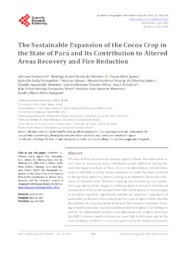The sustainable expansion of the cocoa crop in the state of Pará and its contribution to altered areas recovery and fire reduction.
The sustainable expansion of the cocoa crop in the state of Pará and its contribution to altered areas recovery and fire reduction.
Author(s): VENTURIERI, A.; OLIVEIRA, R. R. S. de; IGAWA, T. K.; FERNANDES, K. de A.; ADAMI, M.; OLIVEIRA JUNIOR, M. C. M. de; ALMEIDA, C. A.; SILVA, L. G. T.; CABRAL, A. I. R.; PINTO, J. F. K. C.; MENEZES, A. J. E. A. de; SAMPAIO, S. M. N.
Summary: The state of Pará, located in the Amazon region of Brazil, has observed in recent years an increase in cocoa (Theobroma cacao) cultivation and has become the largest producer in Brazil. Due to its physiological characteristics, cacao is cultivated in native forests understory or under the shade produced by fast-growing native tree species, serving as an important species for restoration of degraded areas. However, mapping and monitoring cocoa plantation using optical sensor images is a challenge given its botanical and arboreal characteristics that can be confused with other native species at various stages of secondary regrowth. Agroforestry systems are important components of sustainable production in the Amazon and our work sought to better describe the evolution of cocoa plantations in terms of their historical expansion, farming properties practices, land use transitions and fire regimes. Our findings to analyze the relationships between cocoa plantations and hotspots, data from the INPE?s reference satellite between the years 2004 to 2020 were used in this study, polygons classified as cocoa areas, generated by the MapCacau research project, were used, in a total of 69,904 hectares distributed throughout the state of Pará. Finally, we used the protected areas? official limits in the State of Pará to analyze the plantations? occurrence in regions in discordance with environmental legislation. The data show that cocoa-producing properties are statistically fewer than non-producing properties, as well as having lower deforestation rates. In our study, we observed that 52,778 hectares (88.87%) of the cocoa area planted had already been deforested by the year 2008?the threshold of deforestation defined by Brazil?s Forest Code. It was also possible to verify that approximately 20,900 hectares continue to be mapped as forest by PRODES, despite our field data identifying cocoa plantations shaded by explored forest in these areas. Regarding the crop?s formation, the data show a tendency to convert pasture areas to cocoa plantations, proving that cocoa farming expansion in the State of Pará is an important activity for degraded areas recovery and not a main driver of deforestation. The finding that cocoa plantations are still classified as forest by PRODES and project TerraClass highlights the difficulty of mapping this crop using orbital images in a traditional way. Through this paper, it was possible to observe that due to the typical characteristics of perennial crops (cocoa), fire points showed a significant reduction in the mapped areas, highlighting that the expansion of cocoa plantations in the state of Pará contributed to soil protection, to the reduction of greenhouse gas emissions into, in addition to contributing to the generation of jobs and revenue. Finally, we found about 99.54% of the cacao plantations in the State of Pará are located outside of any preservation area, indigenous land or quilombola settlement.
Publication year: 2022
Types of publication: Journal article
Unit: Embrapa Eastern Amazon
Keywords: Amazonia, Cacau, Recuperação, Theobroma Cacao, Área alterada
Observation
Some of Embrapa's publications are published as ePub files. To read them, use or download one of the following free software options to your computer or mobile device. Android: Google Play Books; IOS: iBooks; Windows and Linux: Calibre.
Access other publications
Access the Agricultural Research Database (BDPA) to consult Embrapa's full library collection and records.
Visit Embrapa Bookstore to purchase books and other publications sold by Embrapa.

